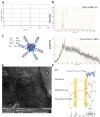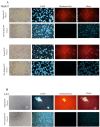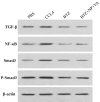Targeted Delivery of Bortezomib Using Retinoid-Based Nanoparticle: Modulating Liver Fibrosis through the TGF-β1/Smad3 Pathway
- PMID: 40636301
- PMCID: PMC12235369
- DOI: 10.34172/apb.43295
Targeted Delivery of Bortezomib Using Retinoid-Based Nanoparticle: Modulating Liver Fibrosis through the TGF-β1/Smad3 Pathway
Abstract
Purpose: Hepatic stellate cells (HSCs) play a crucial role in fibrosis progression. we have developed a targeted delivery approach using A-functionalized nanoparticles for bortezomib (BTZ) specifically for activated HSCs in a mouse model of liver fibrosis.
Methods: The emulsion solvent evaporation method was used to form nanoparticles (NPs) targeted with vitamin A. The characterization of NPs was approved with Fourier-transform infrared (FT-IR), dynamic light scattering (DLS), and scanning electron microscopy (SEM). Also, the biodistribution of NPs inside mice bodies was conducted via fluorescent drug. the cytotoxicity of NPs evaluated in different dose in vitro test. Compared to control groups, a serological evaluation, molecular examination and protein expression were performed based on BTZ's impact on fibrotic index on model mice after treatment with targeted NPs loaded with BTZ.
Results: Characterization of synthesized targeted NPs containing BTZ through DLS, X-ray diffraction (XRD) and FT-IR showed that the size of NPs was optimum and drug was entrapped inside of NPs successfully. Biodistribution of engineered targeted nanoparticles incorporating BTZ in mice showed a gradual tendency of NPs in the liver zone. Moreover, mice treated with vitamin A-targeted containing BTZ showed decreased expression of collagen I, collagen III, and α-SMA; also, the level of expression in TGF-β1/Smad3 and nuclear factor-kappa B (NF-κB) genes suppressed in mice treated with NPs entrapped BTZ. In line with these results, histopathologic and serological results showed significant exacerbation in non-target and drug-free nanoparticle-treated mice. The best result was seen in mice treated with targeted BTZ.
Conclusion: BTZ, in low amounts entrapped in targeted NPc, could ameliorate the fibrotic index in mice models.
Keywords: Bortezomib; Liver fibrosis; Nanoparticles; Proteasome inhibitor; TGF-β1.
© 2025 The Author (s).
Conflict of interest statement
None declared.
Figures
Similar articles
-
[Research on the mechanism of gentiopicroside preventing macrophage-mediated liver fibrosis by regulating the MIF-SPP1 signaling pathway in hepatic stellate cells].Xi Bao Yu Fen Zi Mian Yi Xue Za Zhi. 2025 Jul;41(7):593-602. Xi Bao Yu Fen Zi Mian Yi Xue Za Zhi. 2025. PMID: 40620116 Chinese.
-
Cost-effectiveness of using prognostic information to select women with breast cancer for adjuvant systemic therapy.Health Technol Assess. 2006 Sep;10(34):iii-iv, ix-xi, 1-204. doi: 10.3310/hta10340. Health Technol Assess. 2006. PMID: 16959170
-
Safety, bactericidal activity, and pharmacokinetics of the antituberculosis drug candidate BTZ-043 in South Africa (PanACEA-BTZ-043-02): an open-label, dose-expansion, randomised, controlled, phase 1b/2a trial.Lancet Microbe. 2025 Feb;6(2):100952. doi: 10.1016/j.lanmic.2024.07.015. Epub 2025 Jan 7. Lancet Microbe. 2025. PMID: 39793592 Clinical Trial.
-
pH-Responsive Carrier-Free Nanodrug for Efficient Delivery and Synergistic Therapy.Langmuir. 2025 Jul 15;41(27):17982-17990. doi: 10.1021/acs.langmuir.5c01861. Epub 2025 Jun 30. Langmuir. 2025. PMID: 40587517
-
Systemic pharmacological treatments for chronic plaque psoriasis: a network meta-analysis.Cochrane Database Syst Rev. 2021 Apr 19;4(4):CD011535. doi: 10.1002/14651858.CD011535.pub4. Cochrane Database Syst Rev. 2021. Update in: Cochrane Database Syst Rev. 2022 May 23;5:CD011535. doi: 10.1002/14651858.CD011535.pub5. PMID: 33871055 Free PMC article. Updated.
References
LinkOut - more resources
Full Text Sources











